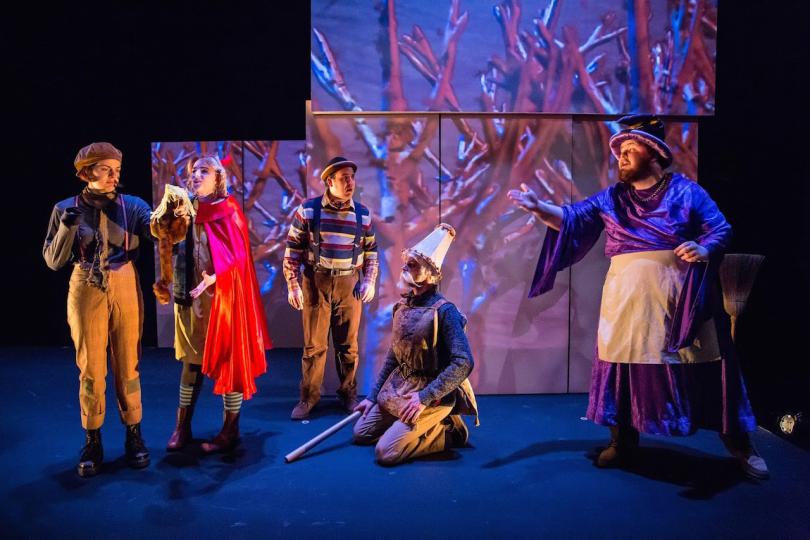Four Humors does it again

Four Humors is exceptionally good at crafting a show like their version of Don Quixote, playing on a short run at the Guthrie Theater’s Dowling Studio. They’ve had a fair amount of practice successfully adapting massive tomes to wildly popular 60-minute comedies, and Don Quixote is certainly going to rank among the company’s successes. It is characteristic of the company’s work—and I say this as high praise. Like so many of Four Humors’ works, a clever, smart and deeply entertaining show. Get tickets if you can.
First, the stagecraft is worth noting because it is so immediately arresting. The set consists mainly of several white panels that can be moved around the stage. Onto these panels are projected videos, serving as sets and sometimes props. What is perhaps most notable is the technological transparency of the video. Rather than prerecording the videos or broadcasting from behind the stage, the camera, people and objects are all visible in a small booth at stage right. The effect is not unlike watching a simplified Pomplamoose video, where the whole thing is set up not only to observe and admire the aesthetics, but to observe and admire in real time the technology and human skill that are producing it.
The show is often a display of the play and of its assembly, something that is relatively commonplace in Four Humors’ productions. Even their minimalist Lolita made some spectacle of using footlights rather than the venue’s lighting grid. The stagecraft-laid-bare thing feels like an ever more typical experience in contemporary art, one that becomes increasingly invisible as it becomes increasingly common.
There is a real danger that a video booth placed in plain view on stage right may be completely invisible to (or at least overlooked by) the audience, and that makes me wonder if certain elements of the show are present to highlight the feeling that we are seeing something we normally wouldn’t. The production doesn’t move the story out of the 1600s, but the video and the way it uses video are distinctly now.
Everyone is wrapped in Mandi Johnson’s gorgeous costumes that, to a large degree, look like they were poached from a mid-1970s BBC sitcom. It’s an anachronistic hodge-podge, but one that has been deliberately constructed. And one that tells you directly that it’s been deliberately constructed. But this is one of Four Humors best moves, generally speaking, here and in previous shows: They never shatter the fourth wall, but they take great care to construct it out of translucent, porous material and then talk about how pretty it is.
Condensing a classic
There are problems that come with compressing such a massive story, however, and at times those problems leak out of the otherwise brightly witty, silly script. Some of the stories feel unhinged to the rest of the adaptation, as if there was a particular checklist of Don Quixote adventures lead writer Nick Ryan and the rest of the company (Jason Ballweber, Ryan Lear, Brant Miller and Matt Spring) felt they should include because they were integral to the original text, not how integral they were to the production at hand.
And at 90 minutes, the pace isn’t frantic, per se, but is unquestionably brisk. That sometimes means the bite of Don Quixote’s absurdity and satire take a back seat to ridiculousness. There was a moment, for example, where the clouds of a “Who’s on First?” routine gathered on the horizon. They quickly dissipated.
What did not dissipate, though, was a nagging feeling that I was watching echoes of satires past, and that time had sanded down the edges so that only the jokes remained. In particular, I was craving something more substantial from the interaction between Don Quixote (Ryan Lear) and the Duke and Duchess (Andy Kraft and Andrea San Miguel, respectively). The Duke and Duchess ache to turn Don Quixote into a source of ongoing personal amusement, a clown who does real damage to people, typically people who can ill-afford their injuries or property losses.
There is something in that thread that wants to come out and talk to us in 2016, something that strikes at the heart of the political absurdity of this historical moment’s inequality, cruelty and deference to power. And I would dearly love to hear Four Humors’ interpretation of that, if only because I am certain it would avoid the ham-fisted guffaw-pandering that often accompanies political talk in comedy. But, alas, I fear it was lost in a sea of funny voices and too little focus on what the victims of Don Quixote’s exploits had to say about him.
Comedy interactions and reactions
On the other hand, the interactions between Matt Spring’s Sampson Carrasco, Don Quixote’s nephew, and his assistant, Scott (played by Nick Saxton), give the whole production a literary heft and bring the absurdism into a gratifying focus. It is through Sampson’s descent into lunacy that the script finds its legs and teeth; Sampson attempts to cure his uncle’s fixation on knight-errants by becoming a knight himself, believing that if he can defeat his uncle in battle, his uncle will snap back to reality.
The plan fails and therein are some of the show’s best moments. Both Spring and Saxton are commendable in their roles. Spring has served Four Humors well in the past with solid portrayals of rational, intelligent, competent characters whose pride ruins every bit of rationality, intelligence and competence they have. This is one of his best performances to date. And Saxton’s performance matches Spring’s energy very well; Scott is a skeptical but forgiving man who can see precisely what is happening. He is an excellent stand-in for the audience and provides an unexpected but welcome anchor to the whole show.
Another unexpected but wonderfully welcome appearance was by Dario Tangelson as Don Quixote author Miguel de Cervantes. The words the script puts in Cervantes’ mouth and Tangelson’s relaxed, assured and good-humored performance give the production historical and literary context and some interesting commentary on the nature of ownership of art.
At any rate, the only thing I really knew about Don Quixote going into the show—apart from the low-level vague ideas about windmills and the like—was that it was written during the era when the Spanish language was transitioning from its earlier Medieval form to the modern variety that we would recognize today. The book is, apparently, filled cover to cover with puns and awkward social situations that hinge on this difference—and, of course, none of that was in the show because why on Earth would it have been? So thank you to Tangelson and the script for letting those of us who don’t know Don Quixote, like, at all, relax a bit and enjoy the show.
Stray observations
- Like Matt Spring’s performance, Brant Miller’s portrayal of Don Quixote’s sidekick Sancho was akin to performances I’ve seen from the actor before—but this was certainly one of the strongest performances of Miller’s time with Four Humors. It’s really nice to see that members of this superbly talented company continue to get better at what they do.
- “A go-nowhere allusion to Moses.”
- The Guthrie remains my favorite place to eavesdrop in the Twin Cities. So choice, you guys. Not only do you invariably get the low-down on hot vacation spots (I’ve heard so many discussions about vacations at the G), it’s almost moving to hear well-heeled, well-dressed ladies of a certain age talk in hushed, thrilled tones about how “experimental” their theater choice was that evening. You go, ladies! You expand your horizons!




